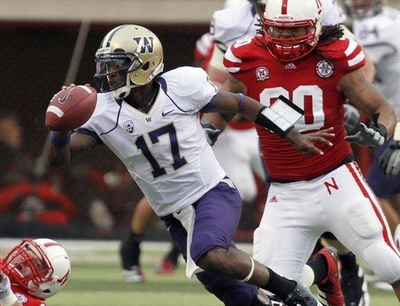A lot of people aren’t going to like this week’s projection. For whatever reason, a lot of people can’t entertain the idea of stock piling talented receivers. Cornerbacks? Sure. Offensive and defensive lineman? You can never have too many. Receivers on the other are treated with great suspicion. The Seahawks have a better group of wide outs today than they’ve had for a long time, but there’s still room for improvement. Mike Williams has regressed this season while Golden Tate still has a lot to prove even if his performances have been improved in recent weeks. Sidney Rice needs to show he can stay healthy after another injury plagued season and Ben Obomanu is steady and reliable, yet unspectacular. Sure, there have been some high profile busts at receiver in recent years, but there’s also been some big success stories. Busts can happen anywhere, including the much fancied offensive tackle and corner back positions.
What the Seahawks don’t have is a receiver capable of scaring the life out of a defense due to pure speed. This week, I’m sending one of the most under rated players in the 2012 NFL Draft to Seattle. Baylor’s quarterback has received a lot of plaudits this year – including a Heisman nomination – but none of it would’ve been possible without Kendall Wright. Those long downfield passes you see Robert Griffin throwing are often to a wide open Wright, who has the speed to stretch the field and the ability to create separation time and time again. This season he, like Griffin, has taken the next step and become a consistent force in the Big 12. Only one player – Western Michigan’s Jordan White – has more passing yards this season. Wright’s stat line reads: 1572 yards, 13 touchdowns.
The Seahawks need to find a quarterback in this draft, even if that means trading up. BUT… if such an option isn’t possible – we have to look at the alternatives in these mock drafts. I anticipate people will ask why I haven’t got the Seahawks taking Dre Kirkpatrick instead – a player adored by many simply because he happens to be 6-2 and coached by Nick Saban. The Seahawks aren’t desperate to add yet another big cornerback, particularly one who isn’t great in coverage (a pretty big part of a corner’s game, don’t you think?). David DeCastro? Perhaps, but eventually the Seahawks have to trust what they’ve invested in the offensive line, including the coaching staff, and look at other areas of the team.
Justin Blackmon takes a fall this week and I have the Seahawks preferring Wright to his Big-12 rival. Why? The Seahawks already have receivers that offer a similar skill set to Blackmon. What they don’t have – and haven’t had for a long time – is someone with elite downfield speed. If they are forced to look at the best options available in the middle of round one, Wright has to be a possibility. And if Seattle is faced with a situation where they’re rolling with Tarvaris Jackson and developing Josh Portis or a later round pick, Wright is also someone who can have an impact running deep route’s early in his pro-career. The idea with these weekly projections is to run through different possibilities, particularly if the Seahawks are going to win their way out of the quarterback stakes.
A final word on Blackmon falling – many people see him as a top-ten lock. I’m guessing I’ll receive the usual flurry of emails arguing against one of the ‘big names’ falling. That kind of thing happens every year and Blackmon is not a can’t miss type player. If he does go in the top ten, it’ll come with a risk factor and it’ll be a reach based on need. I’ve had Blackmon in the top-five picks in previous projections, today I’m looking at the other possibility that he could fall. He’s not going to run a brilliant time at the combine, he does make several frustrating errors (see this video at the 1:16 mark), he’s not got that elite size that teams dream about and there are some slight concerns with his attitude that will need to be checked out. In many ways he’s similar to Michael Crabtree, but Crabtree was a sensational hands catcher with a tremendous wing span. Last year I gave Blackmon a grade in the 20’s and while I expect he probably will go earlier than that, I’m not convinced he’ll be taken in the same range as superior physical prospects like AJ Green and Julio Jones.
One other note… Indianapolis needs to prepare for a big decision. The noises are already being made that Peyton Manning and Andrew Luck cannot co-exist, something we’ve talked about a lot on this blog. The Colts are almost certainly going to have to choose between the two players, potentially freeing up Manning as a free agent. You have to believe teams like Washington (with an owner like Dan Snyder) will jump at the chance to sign Manning to a bumper deal for 2-3 years while quietly grooming a quarterback like Ryan Tannehill in the background. It’s a possible scenario that could open the door for Seattle if you’re hoping for one of the top three quarterbacks.
Of course, the Luck camp may not see a gig in Indianapolis – and following Manning – as the ideal situation for their man. This is a bad Indy team that could easily go 0-16. Following Manning will be like trying to follow up a brilliant first album. The Lucks could push for a better situation – again, possibly Washington but more likely a team such as Cleveland that has the ammunition to trade up. Getting a big deal for multiple round one picks could help the Colts rebuild their terrible roster, back Peyton Manning who’s done so much for that franchise and still plan for the future at quarterback. It’ll be interesting to see how it plays out, but I’ll be stunned if Manning and Luck are on the same roster next season.
 |
#1 Andrew Luck (QB, Stanford) The Colts are facing a difficult situation where they’ll have to either cut Peyton Manning or trade this pick. Interesting times ahead. |
 |
#2 Matt Kalil (OT, USC) The Rams need some offensive playmakers more than anything, but they’ll struggle to pass on a talent like Kalil who can anchor their line for years. |
 |
#3 Morris Claiborne (CB, LSU) He keeps making plays – eleven interceptions in two seasons. Minnesota would surely love a crack at Matt Kalil, but he’s off the board. |
 |
#4 Dwight Jones (WR, North Carolina) With Gene Smith extending his contract, he’ll be tasked with backing his judgement on Blaine Gabbert. That should include an offensive minded coach and a unique target like Jones. |
 |
#5 Matt Barkley (QB, USC) Elite potential and crucially he’s pro-ready. Washington needs someone who can start in year one. |
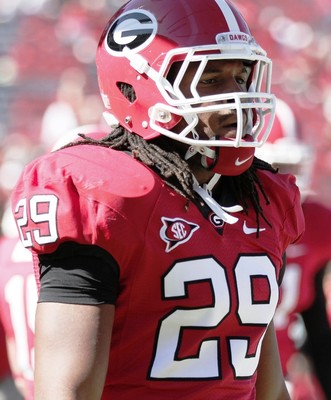 |
#6 Jarvis Jones (LB, Georgia) He says he won’t declare for the draft, but after a prolific season (including 13.5 sacks) a top-ten grade could change his mind. |
 |
#7 Trent Richardson (RB, Alabama) Cleveland needs a playmaker on offense and Richardson would be an instant star for the Browns. |
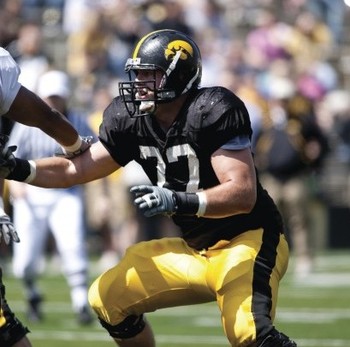 |
#8 Riley Reiff (OT, Iowa) More of a right tackle prospect than a blind-side blocker, Philly needs to sure up that offensive line. |
 |
#9 Robert Griffin III (QB, Baylor) We’re told big changes are coming in the coaching department, which usually means a new quarterback. Griffin will help the Dolphins sell tickets. |
 |
#10 Zach Brown (LB, North Carolina) Tampa Bay fans say linebacker is a big need, so why not draft a player who’s been compared to Lance Briggs? |
 |
#11 Jonathan Martin (OT, Stanford) Arizona’s priority this off season has to be finding a left tackle. Martin isn’t spectacular, but he’s the best available here. |
 |
#12 Luke Kuelchy (LB, Boston College) Tackling machine who looks like a Scott Pioli-type player. A nice fit in Kansas City’s defense. |
 |
#13 Quinton Coples (DE, UNC) The Bills need a pass rusher, but the options at 3-4 OLB are limited. Coples was a lot better in the second half of the season. |
 |
#14 Kendall Wright (WR, Baylor) With three QB’s off the board and no obvious defensive line options – the Seahawks have to think outside of the box. Wright could be the next Mike Wallace. |
 |
#15 Manti Te’o (LB, Notre Dame) San Diego has to add a reliable feature to it’s defense. Te’o can be a leader who performs every Sunday without fail. |
 |
#16 David DeCastro (OG, Stanford) There’s a degree of bandwagon jumping when it comes to DeCastro. That’s not to say it won’t help promote the Washington native into this kind of range. |
 |
#17 Justin Blackmon (WR, Oklahoma State) Could he suffer a fall? He doesn’t have explosive speed, he can make frustrating errors. Blackmon isn’t a top-ten lock. |
 |
#18 Lamar Miller (RB, Miami) Cincinnati has some promising young playmakers and Miller would add another dimension. |
 |
#19 Whitney Mercilus (DE, Illinois) The Jets need to add to their pass rush and could show interest in Mercilus, who leads the NCAA with 14.5 sacks this year. |
 |
#20 Kelechi Osemele (OG, Iowa State) Looks every bit a future NFL guard. Perhaps a little under rated and closer to David De Castro than most think |
 |
#21 Mohamed Sanu (WR, Rutgers) Having added an elite talent at running back earlier, Cleveland continues it’s offensive rebuild with a big playmaker at receiver. |
 |
#22 Janoris Jenkins (CB, North Alabama) Elite talent who only falls due to character concerns. AJ Green and Julio Jones had their worst games against Jenkins in 2010. |
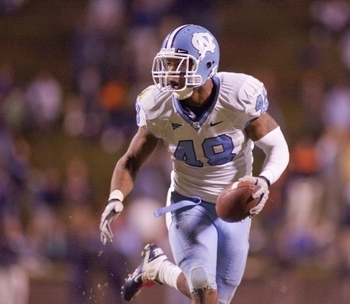 |
#23 Kevin Reddick (LB, North Carolina) Under rated linebacker, would be a nice compliment to Chicago’s defense. |
| #24 Devon Still (DT, Penn State) Versatile defensive lineman who can fit into a number of looks. Pittsburgh can afford to take the BPA. |
|
 |
#25 Dre Kirkpatrick (CB, Alabama) Tall corner who’s flashed real ability in run support, but needs to improve in coverage. John Brantley shouldn’t be abusing any cornerback in the SEC. |
 |
#26 David Wilson (RB, Virginia Tech) Really productive running back for the Hokies who could have a quick impact in Denver. |
 |
#27 Peter Konz (OC, Wisconsin) Stood out last year in a big-name Badgers offensive line. Could return for another year, but ready to have an impact as a pro. |
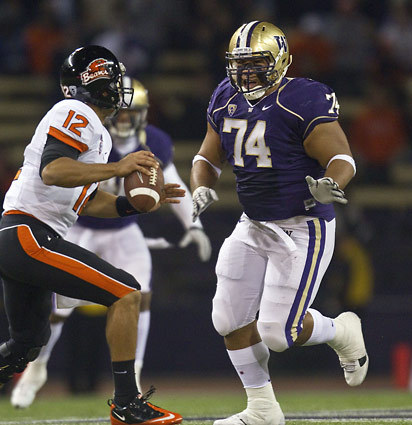 |
#28 Alameda Ta’amu (DT, Washington) Big nose tackle prospect. Houston switched to the 3-4 this year but could still use Ta’amu’s size up front to anchor their defensive line. |
 |
#29 Oday Aboushi (OT, Virginia) I’ve seen Virginia twice this season and Aboushi looks like a NFL tackle. Baltimore needs to bolster that offensive line. |
 |
#30 Nicolas Jean-Baptiste (DT, Baylor) He’s no Phil Taylor, but every time I’ve watched Baylor this year he’s been the one defensive player who looks to have some pro-potential. |
 |
#31 Micheal Floyd (WR, Notre Dame) Production machine but issues off the field will prevent him going much earlier than this. |
 |
#32 Mark Barron (S, Alabama) He’s having a good year but his stock is limited due to the position he plays. This would be a nice get for the Packers. |








